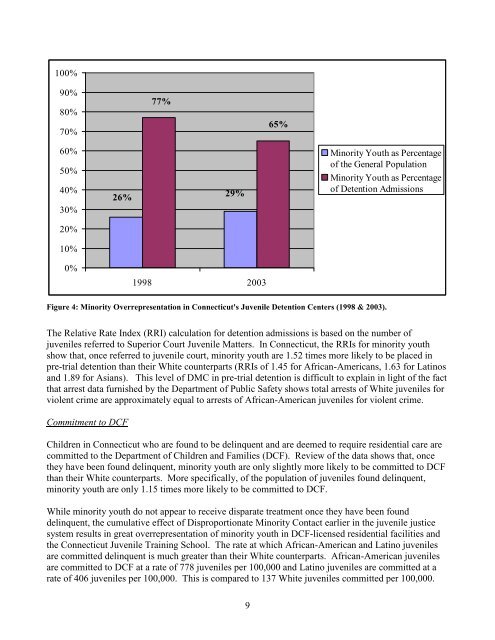Failures in Addressing DMC in Connecticut's Juvenile Justice System
Failures in Addressing DMC in Connecticut's Juvenile Justice System
Failures in Addressing DMC in Connecticut's Juvenile Justice System
You also want an ePaper? Increase the reach of your titles
YUMPU automatically turns print PDFs into web optimized ePapers that Google loves.
100%90%80%70%77%65%60%50%40%30%26%29%M<strong>in</strong>ority Youth as Percentageof the General PopulationM<strong>in</strong>ority Youth as Percentageof Detention Admissions20%10%0%1998 2003Figure 4: M<strong>in</strong>ority Overrepresentation <strong>in</strong> <strong>Connecticut's</strong> <strong>Juvenile</strong> Detention Centers (1998 & 2003).The Relative Rate Index (RRI) calculation for detention admissions is based on the number ofjuveniles referred to Superior Court <strong>Juvenile</strong> Matters. In Connecticut, the RRIs for m<strong>in</strong>ority youthshow that, once referred to juvenile court, m<strong>in</strong>ority youth are 1.52 times more likely to be placed <strong>in</strong>pre-trial detention than their White counterparts (RRIs of 1.45 for African-Americans, 1.63 for Lat<strong>in</strong>osand 1.89 for Asians). This level of <strong>DMC</strong> <strong>in</strong> pre-trial detention is difficult to expla<strong>in</strong> <strong>in</strong> light of the factthat arrest data furnished by the Department of Public Safety shows total arrests of White juveniles forviolent crime are approximately equal to arrests of African-American juveniles for violent crime.Commitment to DCFChildren <strong>in</strong> Connecticut who are found to be del<strong>in</strong>quent and are deemed to require residential care arecommitted to the Department of Children and Families (DCF). Review of the data shows that, oncethey have been found del<strong>in</strong>quent, m<strong>in</strong>ority youth are only slightly more likely to be committed to DCFthan their White counterparts. More specifically, of the population of juveniles found del<strong>in</strong>quent,m<strong>in</strong>ority youth are only 1.15 times more likely to be committed to DCF.While m<strong>in</strong>ority youth do not appear to receive disparate treatment once they have been founddel<strong>in</strong>quent, the cumulative effect of Disproportionate M<strong>in</strong>ority Contact earlier <strong>in</strong> the juvenile justicesystem results <strong>in</strong> great overrepresentation of m<strong>in</strong>ority youth <strong>in</strong> DCF-licensed residential facilities andthe Connecticut <strong>Juvenile</strong> Tra<strong>in</strong><strong>in</strong>g School. The rate at which African-American and Lat<strong>in</strong>o juvenilesare committed del<strong>in</strong>quent is much greater than their White counterparts. African-American juvenilesare committed to DCF at a rate of 778 juveniles per 100,000 and Lat<strong>in</strong>o juveniles are committed at arate of 406 juveniles per 100,000. This is compared to 137 White juveniles committed per 100,000.9
















